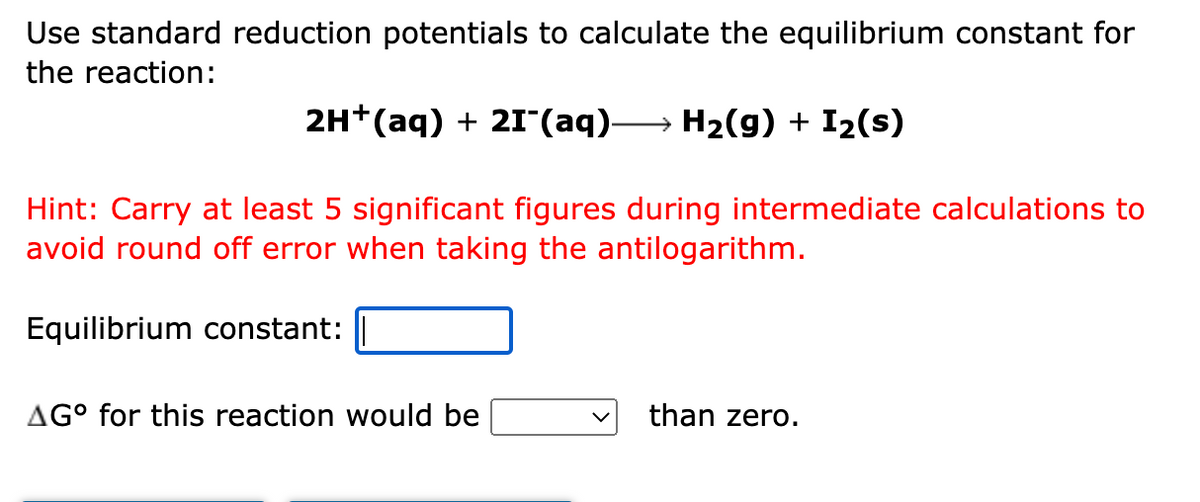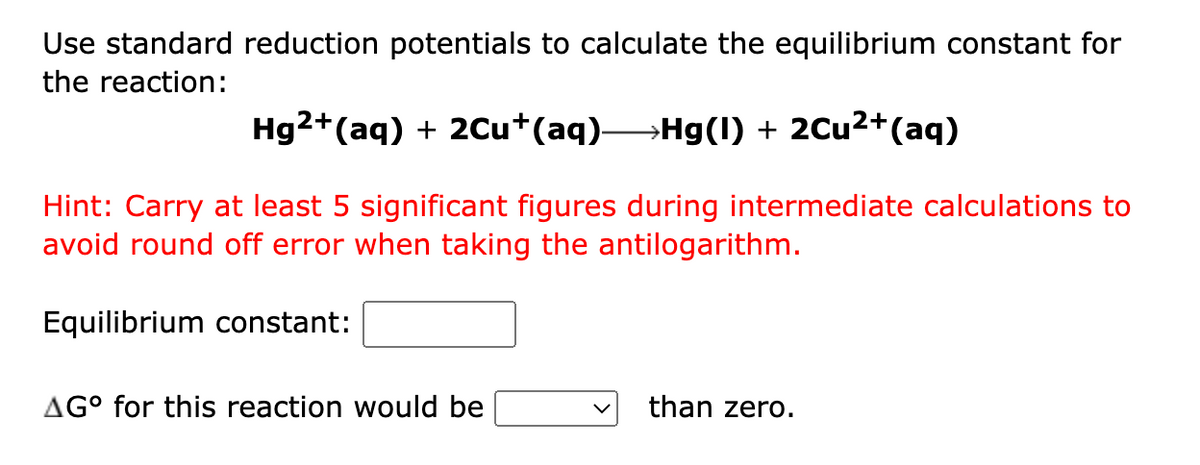Use standard reduction potentials to calculate the equilibrium constant for the reaction: 2H+(aq) + 2I"(aq)- H2(g) + I2(s) Hint: Carry at least 5 significant figures during intermediate calculations to avoid round off error when taking the antilogarithm. Equilibrium constant: AG° for this reaction would be than zero.
Use standard reduction potentials to calculate the equilibrium constant for the reaction: 2H+(aq) + 2I"(aq)- H2(g) + I2(s) Hint: Carry at least 5 significant figures during intermediate calculations to avoid round off error when taking the antilogarithm. Equilibrium constant: AG° for this reaction would be than zero.
Chemistry for Engineering Students
4th Edition
ISBN:9781337398909
Author:Lawrence S. Brown, Tom Holme
Publisher:Lawrence S. Brown, Tom Holme
Chapter13: Electrochemistry
Section: Chapter Questions
Problem 13.40PAE: Calculate the equilibrium constant for the following reactions using data from the standard...
Related questions
Question

Transcribed Image Text:Use standard reduction potentials to calculate the equilibrium constant for
the reaction:
2H+(aq) + 21(aq)–
→ H2(g) + I2(s)
Hint: Carry at least 5 significant figures during intermediate calculations to
avoid round off error when taking the antilogarithm.
Equilibrium constant:
AG° for this reaction would be
than zero.

Transcribed Image Text:Use standard reduction potentials to calculate the equilibrium constant for
the reaction:
Hg2+(aq) + 20u+(aq)Hg(1) + 2Cu2+(aq)
Hint: Carry at least 5 significant figures during intermediate calculations to
avoid round off error when taking the antilogarithm.
Equilibrium constant:
AG° for this reaction would be
than zero.
Expert Solution
This question has been solved!
Explore an expertly crafted, step-by-step solution for a thorough understanding of key concepts.
Step by step
Solved in 2 steps with 2 images

Knowledge Booster
Learn more about
Need a deep-dive on the concept behind this application? Look no further. Learn more about this topic, chemistry and related others by exploring similar questions and additional content below.Recommended textbooks for you

Chemistry for Engineering Students
Chemistry
ISBN:
9781337398909
Author:
Lawrence S. Brown, Tom Holme
Publisher:
Cengage Learning

Principles of Modern Chemistry
Chemistry
ISBN:
9781305079113
Author:
David W. Oxtoby, H. Pat Gillis, Laurie J. Butler
Publisher:
Cengage Learning

Chemistry & Chemical Reactivity
Chemistry
ISBN:
9781337399074
Author:
John C. Kotz, Paul M. Treichel, John Townsend, David Treichel
Publisher:
Cengage Learning

Chemistry for Engineering Students
Chemistry
ISBN:
9781337398909
Author:
Lawrence S. Brown, Tom Holme
Publisher:
Cengage Learning

Principles of Modern Chemistry
Chemistry
ISBN:
9781305079113
Author:
David W. Oxtoby, H. Pat Gillis, Laurie J. Butler
Publisher:
Cengage Learning

Chemistry & Chemical Reactivity
Chemistry
ISBN:
9781337399074
Author:
John C. Kotz, Paul M. Treichel, John Townsend, David Treichel
Publisher:
Cengage Learning

Chemistry: The Molecular Science
Chemistry
ISBN:
9781285199047
Author:
John W. Moore, Conrad L. Stanitski
Publisher:
Cengage Learning

Principles of Instrumental Analysis
Chemistry
ISBN:
9781305577213
Author:
Douglas A. Skoog, F. James Holler, Stanley R. Crouch
Publisher:
Cengage Learning

Chemistry
Chemistry
ISBN:
9781305957404
Author:
Steven S. Zumdahl, Susan A. Zumdahl, Donald J. DeCoste
Publisher:
Cengage Learning